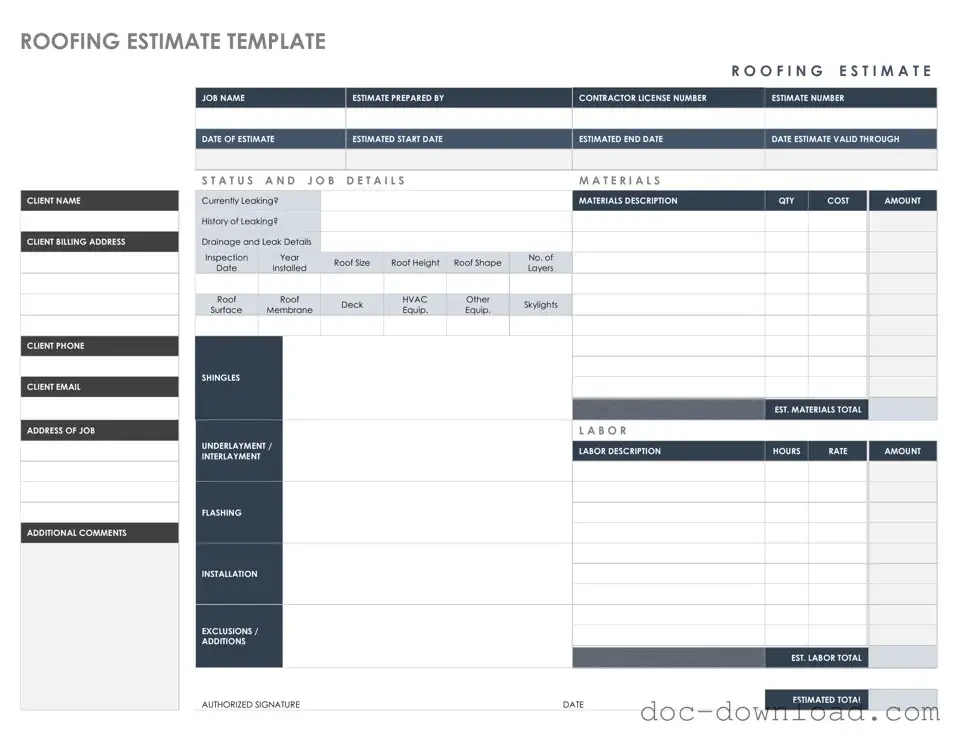The Roofing Estimate form shares similarities with a Construction Contract. Both documents outline the terms and conditions of a construction project. A Construction Contract specifies the scope of work, materials to be used, and the payment schedule. Just like a Roofing Estimate, it provides clarity on what the contractor is responsible for and what the homeowner can expect. This helps prevent misunderstandings and ensures that both parties are on the same page before work begins.
An Invoice is another document that resembles the Roofing Estimate form. Both serve as financial documents that detail costs associated with a project. While the Roofing Estimate provides a preliminary cost before work starts, the Invoice reflects the actual costs incurred after the work is completed. Each document plays a crucial role in the financial aspect of home improvement, ensuring transparency in pricing.
A Work Order is another document that aligns with the Roofing Estimate. It is often issued after the estimate is accepted and signifies that the contractor is authorized to begin work. Like the Roofing Estimate, it includes details about the project, such as timelines and costs. Both documents serve to formalize the agreement between the homeowner and the contractor.
In addition to the various estimates outlined, understanding the legal documents associated with home ownership can be crucial; for instance, a California Durable Power of Attorney grants an individual the authority to make decisions on your behalf. This is particularly important for financial or healthcare matters, enabling you to ensure your preferences are adhered to if you become incapacitated. For comprehensive guidance on filling this essential document, visit californiapdffoms.com/.
The Change Order document is similar in that it addresses modifications to the original agreement. If changes arise during the roofing project, a Change Order will specify the new terms and any additional costs. This document is essential for keeping the project on track and ensuring that both parties agree to the alterations, much like how the Roofing Estimate sets the initial terms.
A Proposal is another document that resembles the Roofing Estimate. It is often the first step in the contracting process. A Proposal outlines the contractor's plan for the project, including costs and timelines. The Roofing Estimate, while more focused on pricing, serves a similar purpose in providing homeowners with an overview of what to expect from the project.
The Purchase Order is similar to the Roofing Estimate in that it confirms the purchase of materials or services. While the Roofing Estimate provides a cost estimate for the roofing project, a Purchase Order is a formal request to buy the materials needed for that project. Both documents are essential for budgeting and ensuring that all necessary resources are accounted for.
The Bid is another document that shares common ground with the Roofing Estimate. A Bid is typically submitted by contractors when competing for a project. It includes pricing and project details, similar to a Roofing Estimate. Both documents aim to provide homeowners with a clear understanding of costs and services offered, enabling informed decision-making.
The Warranty document is also relevant in this context. While the Roofing Estimate focuses on costs and project scope, the Warranty outlines the guarantees provided by the contractor regarding the quality of work and materials used. Both documents are important for homeowners, as they establish trust and confidence in the contractor's services.
Finally, the Final Report can be compared to the Roofing Estimate. After the roofing project is completed, a Final Report may summarize the work done, costs incurred, and any issues that arose. Like the Roofing Estimate, it serves to document the project, but it does so after the fact. Both documents are crucial for record-keeping and ensuring that the project meets the homeowner's expectations.

